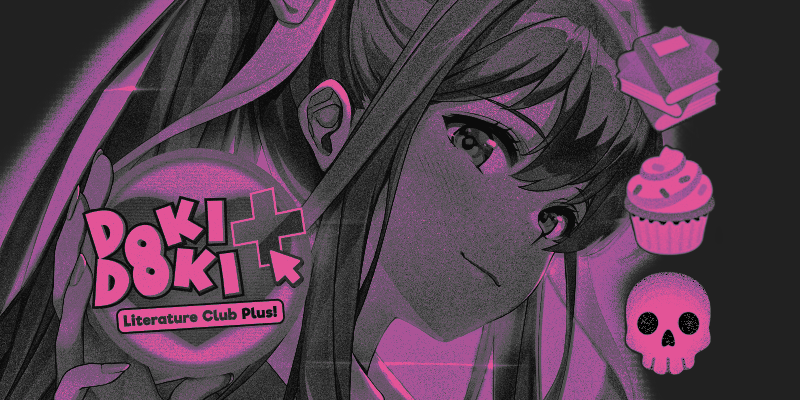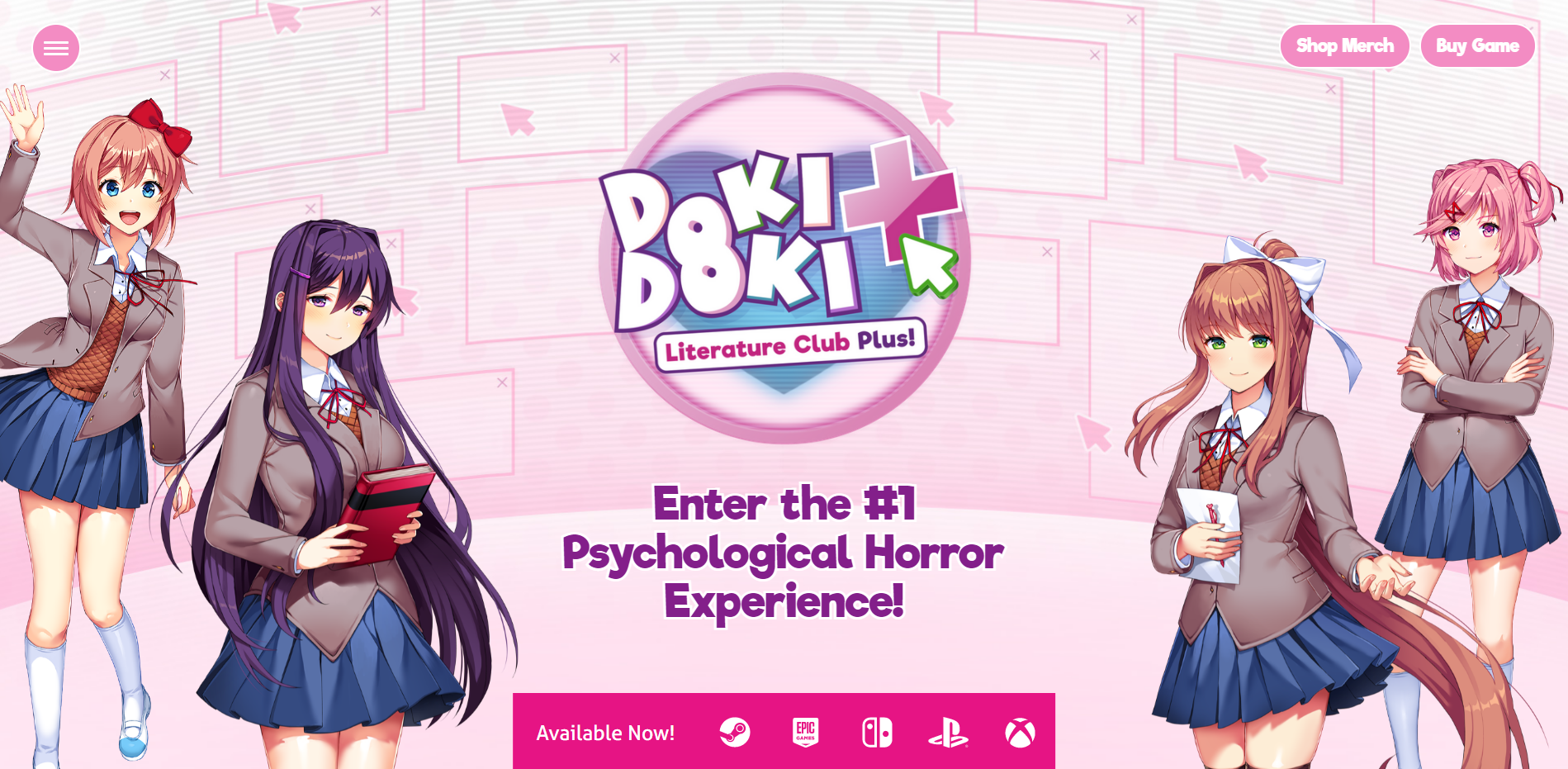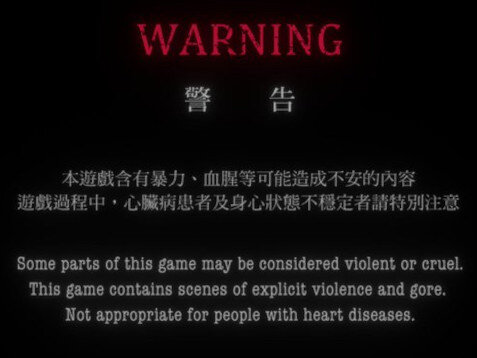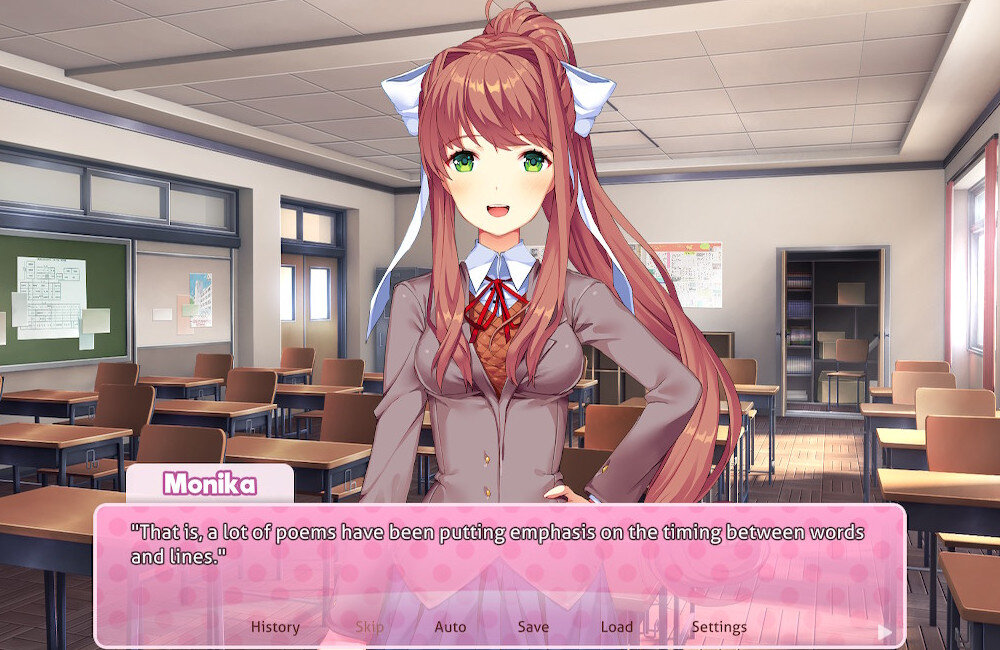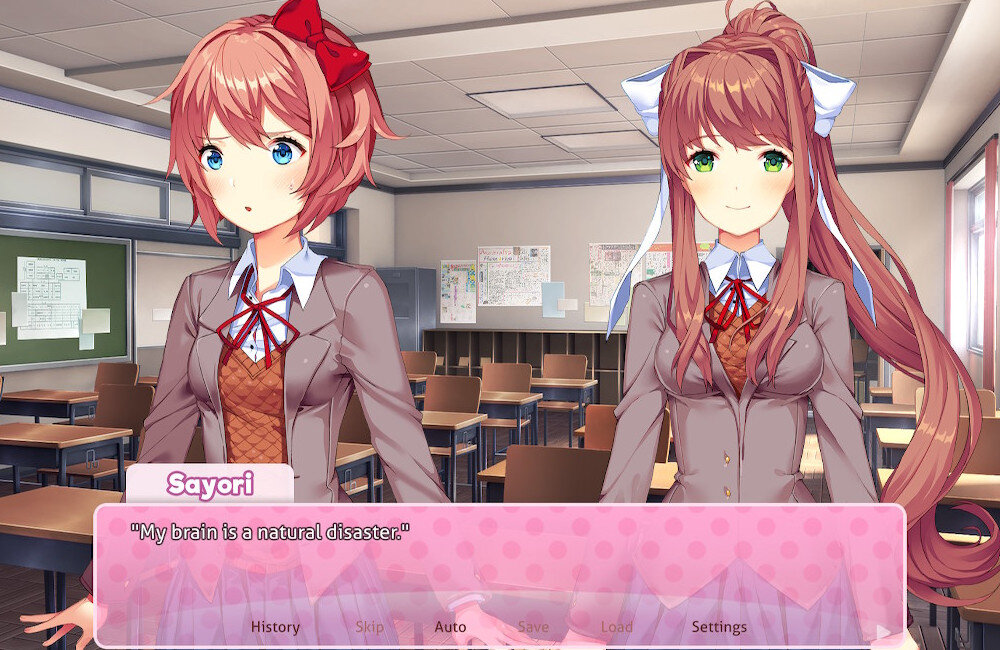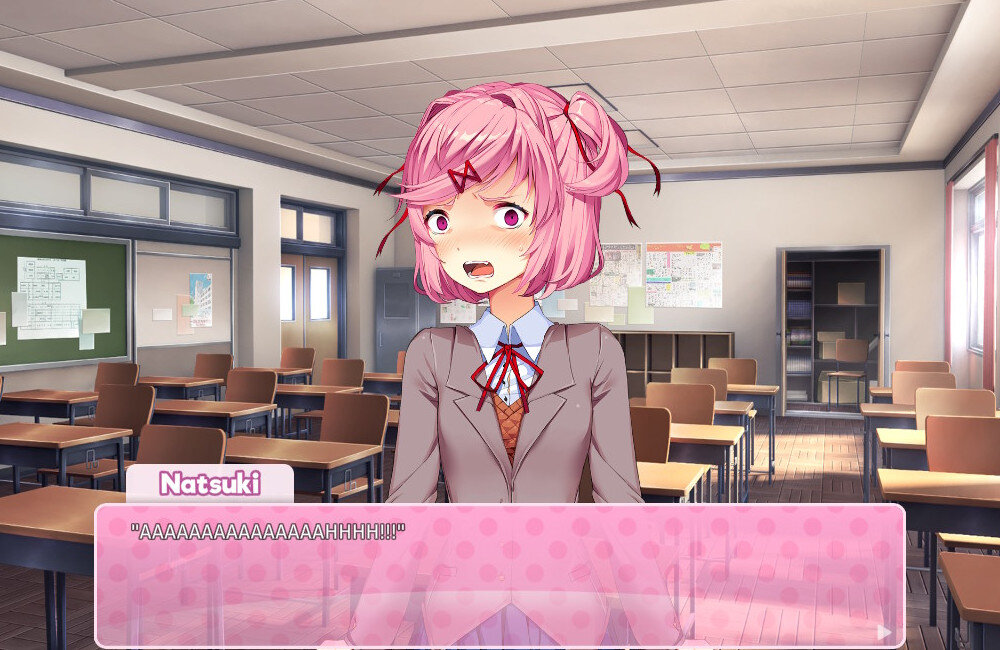Doki Doki Literature Club Plus!
DOKI DOKI LITERATURE CLUB! is an indie dating sim about cute girls and poetry, underneath which is an edgy horror story with elements from UNDERTALE, underneath which is a heartfelt game that uses its genre in extremely clever ways - all while fitting in a small, easily-digestible package. It’s a game about digging into things that seem trite and finding something really meaningful.
I fucking love this game.
But I’m getting ahead of things.
In DOKI DOKI LITERATURE CLUB!, you play as a lazy teenage boy who joins an after-school literature club whose other members are anime stereotypes. You write and exchange poems with the girls, tailoring your style to impress the one you’re most interested in, gradually unlocking special scenes where you get to know them better and a potential romance starts to blossom. It’s a visual novel, so most of the game is reading text on the screen as the story plays out, interspersed with player choices that lead to branching paths (e.g. pursuing one girl over the others).
But I already told you there was more to it than that.
It’s right in the middle of the official website, too.
🎵 “One of these things is not like the others / One of these things doesn’t belong” 🎵
I won’t front; that hook right there is why I first picked up the game when it came out in 2017. (It was just re-released as DOKI DOKI LITERATURE CLUB PLUS! in 2021; I’ll talk more about that at the end.) But I was surprised to find the game really impressing me way before that hook paid off. There’s a lot more here than just a juxtaposition of something cute and something scary.
It’s also a game that hits hardest if you don’t know exactly what’s coming before you play.
Which means I gotta talk a bit about warnings before we get to the meat of this review (when I’ll spoil lots of stuff in order to gush about the game in detail).
Warnings, spoilers, and responsibility
In the United States, the history of warnings being attached to video games by their creators largely swings between prophylactics and insincere hype-building.
In the late 1980s and early 1990s, titles like SPLATTERHOUSE and the original MORTAL KOMBAT were released that included depictions of gore never before seen in games. This was mostly meant to emphasize the over-the-top violence that was part of these games’ aesthetic, not to disturb audiences, but it ended up sparking a wider panic over portrayals of graphic violence (among other subjects) in video games. This led to the creation of the Entertainment Software Ratings Board (ESRB), responsible for rating all games released in the US.
Following that, it was common for games in the late 1990s and early 2000s - especially horror games - to open up with a warning indicating that some brutal shit might be about to go down. This was essentially the “please don’t legislate me, daddy Congress” period of video game warnings.
RESIDENT EVIL 2 (1998)
SILENT HILL (1999)
SILENT HILL 3 (2003)
Because these warnings arose as a reaction to social panic, they faded as the panic did. The ESRB still rates games, but custom warning screens like the above aren’t standard industry practice at the time of this writing. RESIDENT EVIL VILLAGE released in 2021 and features no warnings at all - and that’s a game that begins with a young mother getting shot in the face right in front of you, shortly before someone bites off half your hand on-screen.
When horror games do include “warnings” these days (other than flashing lights warnings for people with photosensitive epilepsy), they’re usually kinda gimmicky - like when old filmmakers would offer fake life insurance polices in case people got “scared to death” by their movie. SILENT HILL: SHATTERED MEMORIES had a really hokey “psychology warning” to get you jazzed about one of its core features (which, as I’ve mentioned before, was pretty cool actually). The warnings before DETENTION and DEVOTION seem more sincere, but are largely throwbacks to older horror games (i.e. they include, verbatim, the warnings from RESIDENT EVIL 2 and SILENT HILL 3).
And all the way at the extreme end, there’s games like CRY OF FEAR - whose warning combines the dumb “my media is so sCaAaRy it might kill you!” stuff from those old movies with a more standard warning, and turns the idea of suicide into some really bad taste marketing/hype. The real warning there is that this game is going to trivialize serious shit to score aesthetic points in what is basically just an uncreative Silent Hill knock-off. (And trust me, that’s all that game is.) Here’s a bonus review for ya, free of charge: Fuck CRY OF FEAR. Don’t waste your time on that game.
SILENT HILL: SHATTERED MEMORIES (2009)
DETENTION (2017)
CRY OF FEAR (2012)
And then there’s DOKI DOKI LITERATURE CLUB!.
The original game began with a simple one-sentence warning, like back in the late 1990s:
DOKI DOKI LITERATURE CLUB! (2017)
The first time you load the game, this warning goes on to add that “Individuals suffering from anxiety or depression may not have a positive experience playing this game,” and then concludes: “For those with extra concern for their mental health, our recommendation of the safest approach is to avoid playing DOKI DOKI LITERATURE CLUB!.”
It’s not that DOKI DOKI LITERATURE CLUB! is “more hardcore” or “more disturbing” than CRY OF FEAR or RESIDENT EVIL VILLAGE or whatever - that depends primarily on your own personal experience, and you know yourself way better than I do. But the way other games have handled these screens, you might think the warnings here are just for hype.
Nope. They mean it.
And part of the reason why I want you to know to take these warnings seriously (aside from the obvious) is cos I want people to be able to experience this game with as little prior knowledge as possible, but while still being safe.
A large part of the game is about playing with your expectations, and authentic surprise can be a really powerful experience.
If you want to learn more about all the content warning features and controls that got added in DOKI DOKI LITERATURE CLUB PLUS!, check the developer blog that explains them.
CONTENT WARNING:
Discussions of
depression, self-injury, and suicide
And one last time: If you haven’t already, play the game before going on with this review.
A full playthrough of the main story is only about four hours, and has no difficult gameplay sections. (It gets a little trippy, but you’ll know when you’re really done - the end credits are real memorable.) You’d also be supporting an indie developer who makes dope stuff.
Go buy the PLUS! version with extra goodies and better interfaces.
The original is still free on Steam, too, if you’re tight on cash.
Starting after the next header, this review will include some major spoilers for the game. I’ll try to hold back as much as I can, so you’re not going to see everything that the game kicks ass at, but I’m gonna reveal some big stuff.
Oh, and while we’re at it, this review will also have some spoilers for PUELLA MAGI MADOKA MAGICA.
Let’s go.
Surprising sincerity
The main mechanic in DOKI DOKI LITERATURE CLUB! is reading.
The plot very gradually unfolds, one textbox at a time. This is the sort of thing I mentioned as being agonizing when I reviewed ŌKAMI, but in this case it’s what we’re here for: this is a visual novel. All the dialog isn’t a distraction, it’s the intended experience. (Also, the text speed is much faster than the slug-on-Benadryl-using-a-typewriter pace in ŌKAMI. Which, y’know, helps.)
More importantly, though, the writing in DOKI DOKI LITERATURE CLUB! is also really good, actually. On multiple levels. That’s weird to say, because any given textbox in the game looks like a mediocre translation of a generic dating sim (which is by design). But still, the way the game reveals itself through its writing is impressive.
To be able to give examples succinctly, lemme quickly introduce our cast:
First, there’s the main character. You stay up late playing video games and watching anime, and have no ambitions greater than coasting by - until you discover the literature club is full of cute girls.
You’re about as generic as a dating sim protagonist gets.
Sayori is your neighbor and childhood friend. She’s friendly and wants to make everyone happy, but also a little scattered and clumsy.
Yuri is tall and shy. She’s passionate about literature - especially very dense and complicated stories - but painfully awkward around people.
Natsuki is short and bossy. She loves baking, manga, and cute things - but hates when people look down on her.
Lastly, Monika is the club president. She’s smart, athletic, sociable, and mature. She moves the plot forward and provides tutorial guidance (like “don’t forget to save your game”).
After you pick a name for your character, you spend your first day getting introduced to everyone, at the end of which you get introduced to the game’s second main mechanic: the poetry minigame.
At the end of each day in the game’s story, you will go home and “write” a poem. You do this by picking words from lists; different words will appeal to the three girls differently (Monika isn’t a romantic option) - pick a word they like, and a little sprite of them will jump with joy. Then the next day, everyone shares their poems, and you get special scenes and dialog with the girl who liked your poem the most.
You can also save and load the game at any time - so if you ended up writing a poem that didn’t quite win over the object of your affection, you can just load a previous file and try again.
The whole first day, the game tries its best to convince you it’s just another dime-a-dozen dating sim - and then on the second day, you see the girls’ poems. They’re surprisingly good, but more impressive is the way the characters explain them to you. It’s not just what the poems are “about” - they go into the reasoning behind their word choices and structure, too.
Day by day, the particular girl you are wooing starts to reveal more about herself, and just like the poetry discussions, it ends up being fascinating. For each character, the game unfolds the initial cliché into a portrait that shows how their interests in literature reflect their personalities and life struggles, which in turn get expressed in their poetry using stylistic conventions that are specific to them.
Monika breaks down why she’s been experimenting with a more “freeform” structure for her poems
See, this is part of what’s cool about the hook of “why is this thing that looks like a dating sim calling itself a horror game?” - I would never have played this game otherwise, but I found myself enjoying the portions of the dating sim where I just got to read cool poems and learn about these people.
And the slow, textbox-by-textbox crawl of the script works well here, precisely by drawing things out and forcing you to slow down and get to know the characters.
Natsuki explains to you how manga - even the exceedingly moé slice-of-life volumes she keeps in the closet at school - is real literature. And then you learn how her defensiveness isn’t just a character trope, but a response to repeated dismissal of her interests - and her deliberate indulgence in the aesthetic of pink hair and cupcakes with frosting that looks like kittens starts to feel like rebellion, similar to the real-world history of the kawaii movement in Japan.
Or, if you get to know Yuri better, you start to really understand why casual conversation and social attention are so difficult for her. She’s torn between wanting to share and wanting to hide. When Yuri tried to express her passions in the past, she would get ridiculed for coming off too strong - or for the weirdness of her interests, which include bleak fantasy/horror novels and knives. But when someone provides her a comfortable space, she begins to open up - and you can see her confidence, elegance, and insight shine.
And Sayori eventually reveals to you that her drive to make everyone happy comes from a deep depression she’s kept hidden all her life, which leads to frequent suicidal thoughts.
Sayori adorably ends up saying this after explaining that she’s been brainstorming so hard, it’s like she had a “brain hurricane”
See, this is actually the first major tonal shift in the game - not the hard swerve into overt horror that comes later. And the impact of this shift doesn’t come primarily from juxtaposition (i.e. this is a heavy subject matter for such a saccharine setting), but from how sincerely the game handles the topic.
Sayori suffers from constant negative self-talk. She feels worthless, and that people caring about her is only bad for them, which makes reaching out painful and causes her even more distress. If she can’t make everyone around her happy, then what’s the point? Wouldn’t everyone be better off without her? Having dealt with suicide in my own life, I can tell you:
That’s pretty real.
By which I mean both “it hits hard” and “it’s fairly accurate to what we actually understand about suicide in real people”.
Let’s be honest - most media depictions of suicide treat it as just a handy storytelling device. It’s used as a convenient shorthand for “this character is really sad” or “this story is really dark” - or, in especially shitty cases, “this character is sooo cRaAaZy”. This is especially pervasive in horror games, even good ones. Games with multiple endings like SILENT HILL 2 and HEAVY RAIN often have “bad endings” that involve suicide as a way to emphasize the player’s failures (e.g. “you didn’t do the right things, so whoops, now you’re Too Sad To Live”). Meanwhile, action-horror games like DEAD SPACE love to have people kill themselves in front of the player (usually because they’re been through some terrible experience, which made them “sooo cRaAaZy”) just as a gruesome visual to set the tone. I’m not saying these games are terrible - in fact, some of them are among my favorites - but think about how they’re characterizing suicide: as the inevitable consequence of personal failure, or as a sign that someone’s mind is so broken that they are unintelligible.
None of this really reflects the reality of suicide.
Although conditions like major depression do increase the risk of suicide, studies repeatedly show that a tiny minority of people with those conditions will ever attempt suicide. Actively making plans to kill oneself is more complex than just being “really sad”.
What you’re seeing in Sayori during these scenes is formally called “perceived burdensomeness” - that is, the feeling that one is worsening the lives of people around them, and that others would be better off without them. Recently, there’s been a lot of research suggesting that perceived burdensomeness is a major factor that contributes to making plans to kill oneself. But you don’t need to be current on the research to recognize the powerful authenticity here. Dan Salvato (the writer and lead developer) has said that he based most of this particular dialog from personal experience, and after the game’s release has received tons of outreach from people with similar experiences. This is one of the very few games I’ve seen that both treats suicidal thoughts as a human experience rather than a plot device and tries to explore them in a genuine way.
I also need to stress that, while this conversation with Sayori is a turning point, it’s not a twist.
Leading up to the conversation, there are outward signs that something is up (some of which are more obvious than others). When the conversation happens, there isn’t any abrupt stylistic shift: the way Sayori’s dialog is written doesn’t change, the music doesn’t suddenly cut out, and there’s no extra visual or audio effects to frame the introduction of this topic as jarring or dissonant. The music for this scene is sad, but gentle, and fits in with the rest of the game’s soundtrack, even being used for other moments too. Everything about the presentation says that this subject matter belongs here, that it’s part of the same cloth as the rest of this otherwise lighthearted dating sim full of hair bows and clichés.
A big part of the experience of playing DOKI DOKI LITERATURE CLUB! for the first time is about “that moment” - i.e. the moment where it reveals itself to be completely different from what you expected. For a lot of people, that moment comes when the game drops some of its more gruesome bombshells on you, or during its explicitly horrific/unsettling moments that fill the second half of the game. But for me, it was these conversations with Sayori. After these scenes, I would’ve been content even if the game would’ve had no horror elements, and dropped no bombshells.
But they’re still coming.
You can already hear the bombers whistling overhead.
Save me, load me
If the way Salvato handles Sayori’s depression is the high point of the game’s writing, then the way it handles Sayori’s death is the high point of the game’s overall design. The moment itself is shocking, but what’s genius is how the game uses its mechanics to explore the emotions around it.
As a visual novel, the main thing you do is make choices, and the main result of those choices is branching outcomes.
So the game mechanics naturally lead you to the same question that your character is experiencing in this moment: What could you have done differently?
Should you have picked a different dialog option?
What did you miss?
I especially love how this meshes with the poetry minigame. There are some words that seem like they really don’t belong (usually because they were bleak or harsh) - by passing over them, did you miss a chance to dig deeper? Or maybe you picked one, and were surprised to see who reacted to it - was that a hint that you didn’t properly investigate, somehow?
Where exactly was the threshold that you didn’t know you crossed?
Using the conventions of visual novels to mimic the sense of guilt and confusion that comes in the wake of an unexpected tragedy is brilliant.
Of course, in a video game, you can just re-load an earlier save file, and try again.
But not here.
Breaking the rules it told you before, the game doesn’t let you go back and fix things this time. Instead, it starts over, beginning back on the first day you joined the literature club…but without Sayori, as though she never existed. Monika, Natsuki, Yuri, the main character - all of them go through the same motions you’ve just played through, with no sense of loss or anything missing. Only you, as the player, know who should be here.
What an amazing mechanical representation of the internal wounds of grief - of the way it feels wrong that the rest of the world can be oblivious to what you’ve lost.
This is also where the game begins to introduce horror visuals for the first time, and you can feel the story start to press its face up against the fourth wall. These distortions visually reinforce the concept that, fundamentally, Sayori’s absence is wrong.
This sort of shit is what I absolutely love about these tiny indie titles like DOKI DOKI LITERATURE CLUB! and BRAID and NIGHT IN THE WOODS and so many others: they can achieve a level of cohesion between structure and story that’s just completely out of reach for bigger games made by major studios. There are fewer singers in their choir, but they’re all hitting exactly the same note - and the song is so much clearer, especially when you compare it to triple-A titles.
Like, say, BIOSHOCK INFINITE - a game that’s won widespread critical and audience acclaim for its complex and expensively-rendered story about guilt and atonement, about agency and destiny.
Yes, I too have read ROSENCRANTZ AND GUILDENSTERN ARE DEAD
Why is that game a first-person shooter?
Why is that game a first-person shooter where normal people run at you screaming for your blood??
Why is that game a first-person shooter where normal people run at you screaming for your blood, and you kill them by ripping their throat out with a grappling hook and shooting carnivorous crows out of your hands???
In a sense, these are unfair questions: BIOSHOCK INFINITE is a first-person shooter because the original BIOSHOCK was a first-person shooter (even though the genre fits the setting of BIOSHOCK much better than BIOSHOCK INFINITE). And it’s not like the publicly-traded Take Two Interactive, owners of other diamond-studded properties like BORDERLANDS and RED DEAD REDEMPTION and GRAND THEFT AUTO, has an abundance of adventurous spirit here - especially when it comes to figuring out what to do with an expensive staff of game developers who have a ton of experience specifically with making first-person shooters. On top of that, the sheer amount of people necessary to create a game like BIOSHOCK INFINITE is going to lead to creative drift between its many complex elements, as it’s harder to keep that many people tightly aligned.
But, as it turns out, when you’ve got the game up on the screen in front of you, knowledge of the video game industry’s constraints isn’t what’s shaping your emotional reactions.
Sure, there are big-budget releases like THE LAST OF US that have truly heartstring-pulling moments, beautiful visuals, compelling voice-acting, and dozens of hours more playtime - but those things describe the scope of the game, rather than its impact. DOKI DOKI LITERATURE CLUB! doesn’t have to be a day’s worth of full-course meals - it’s just a cupcake. A damn good cupcake.
Dollar for dollar, you often can’t beat these incredibly tightly-executed little indie passion projects when it comes to sincerity and clarity - particularly in their mechanics.
And I haven’t even gotten to the stuff you thought this review was going to be about.
The stuff you thought this review was going to be about
I love the horror stuff in this game.
If you’re a fan of horror, you’ll probably find it charming and fun.
If you’re not, you’re still in for a treat, and not one that revolves around sudden loud noises.
There’s some traditional scary faces, some subtle distortions of visuals and soundtracks, some SCP-style cryptic messages, some unnerving moments where characters try to sneak in a “please help me” (or something more sinister) without being noticed, and even more goodies I won’t give away. It’s all very internet-y, without being based on screaming-in-your-face jumpscares.
The mash-up of these creepypasta sensibilities with the cute user interface of a visual novel is totally my jam. It’s like…evil Vaporwave (especially in the 2021 re-release). It reminds me a bit of Windows 95 Tips, Tricks, and Tweaks, a nostalgia-horror project by Neil Cicierega. (Yes, that Neil Cicierega. [Also that Neil Cicierega.])
And there’s also more, uh, direct horror, too.
I’m not gonna show ya. Go play the game
As you continue to play after Sayori’s death, things start to spiral. Without her friendly presence, interactions become colder and more dire, and arguments become more vicious. The longer this goes on, the more the game itself starts to fall apart - and the characters in it become more desperate and raw, like animals stuck in a cage that’s starting to sink.
This is also where the game gets a lot edgier, and I wanna take a minute to unpack that.
Part of the post-Sayori playthrough involves learning darker truths about the remaining characters. You get a glimpse of the home life that leads Natsuki to keep her manga collection at school, and you find out that Yuri has a habit of cutting herself. You might feel a similar sort of “should I have noticed this before?” reflection like with Sayori’s depression, but unlike before, the game isn’t exploring these parts of the characters anymore - it’s just using their edges. This is deliberate, as the game’s goals have shifted along with its genre (from dating sim to horror), but it means there’s some dissonance between how DOKI DOKI LITERATURE CLUB! compassionately portrays Sayori’s suicidality and how it uses stuff like Yuri’s self-injury for shock.
But, much like calling yourself “edgy” in real life, the worst part about DOKI DOKI LITERATURE CLUB!’s “edginess” is the company that implies. As Dan Salvato himself said, making bad things happen to cutesy characters isn’t that original. Especially these days.
Over the past decade or so, there’s been an upsurge in anime and manga that take traditionally saccharine genres and add gruesome elements to it. The most recent trend is propelled largely by the success of the 2011 anime PUELLA MAGI MADOKA MAGICA.
The show begins as a typical “magical girl” anime like CARDCAPTOR SAKURA or SAILOR MOON, where a cute magical animal gives a group of school girls special powers to beat goofy monsters. Then, in episode 3, one of those monsters suddenly bites a girl’s head off and eats the rest of her while her friends scream. From then on, the show becomes a train of tragedies, taking every element of the magical girl genre and making it as ridiculously grim as possible, ultimately revealing that “little girls suffering” is literally the fuel source that keeps the universe going.
SAILOR MOON (1993)
Despite the praise that PUELLA MAGI MADOKA MAGICA got for being “groundbreaking”, this sort of thing has been done before (manga reviewer Yerocha has a pretty good run-down). And the pitch of “magical girl, but dark” shows a pretty deep ignorance of the source material. You see a lot of people saying things like “take children and turn them into warriors fighting aliens or demons and realistically that's going to leave a lot of psychological scars”, as though magical girl anime never grappled with darkness or tragedy before. But it always has.
At the end of the first season of SAILOR MOON, the heroine’s friends are all killed, and she struggles to find the strength to move on without them. Then the love of her life gets brainwashed by the villain, fights her, and is also killed. When she beats the villain, she’s lost everything.
For as much praise as PUELLA MAGI MADOKA MAGICA got for “deconstructing” magical girl anime, it ended the same way that season one of SAILOR MOON did, 20 years before it: The heroine makes a wish to undo all the horrors she and her friends have endured, at the cost of their memories together.
PUELLA MAGI MADOKA MAGICA (2011)
See, the difference between magical girl shows like SAILOR MOON and “dark magical girl” shows like PUELLA MAGI MADOKA MAGICA isn’t that “bad things happen” - it’s the point of bad things happening. In the source material, they were part of a story in which real-world positive forces like friendship could ultimately overcome the hardships of life; these shows don’t lack tragedy, they just lack gore. The “dark” versions typically don’t have much to say beyond “bad things happen”, but they do have fleets of talented animators rendering a body going limp as its spine is severed.
The shows that came after PUELLA MAGI MADOKA MAGICA went even harder, taking a pornographic glee in depicting magical girls crying, pissing themselves with fear, killing each other, and more. It’s like a bunch of people loved THE END OF EVANGELION while growing up, but the lesson they learned was that the apex of anime is shoving little girls with colorful costumes into woodchippers.
Despite appearances, DOKI DOKI LITERATURE CLUB! ain’t actually about that woodchipper life. But it does get pretty edgy at times.
The risk with edge is that it can start to overwhelm more thoughtful characterization, and that does happen a bit here. Technically, most of the stuff about self-injury in the game is being said by characters who are deliberately being shitty about it to make Yuri look bad, but it’s still not a great look for the game overall. For my money, this is the one area I wish had more work put into it.
Unlike PUELLA MAGI MADOKA MAGICA or CRY OF FEAR (or any number of other examples), though, the edginess doesn’t completely overwhelm the game. And that’s largely because, in DOKI DOKI LITERATURE CLUB!, the edginess isn’t actually the point.
The horror in this game is like the icing on a cupcake: it’s sweet, it’s a major part of the appeal, and the game wouldn’t be the same without it - but you need the cake. DOKI DOKI LITERATURE CLUB!’s horror is earned and carried by a deep understanding of, and genuine affection for, visual novels.
And that understanding is also the basis for plenty of ribbing/critiques of the genre conventions that the game is playing with. Dan Salvato has said he has a love/hate relationship with anime, and it shows.
Through the glitches and the gore, this understanding of the source material is where DOKI DOKI LITERATURE CLUB! comes back to at the end.
Ultimately, the game is somewhat about how most dating sim visual novels are kinda fucked up if you think about it. The girls in this game end up cracking under the pressure of being constructed to have their world revolve around a personality-less protagonist; what’s really hurting them is having to be characters in a dating sim in the first place. Being fully-realized people is at odds with having a player-shaped hole cut out of them, and even their bodies are transformed to fit the goals of the dating sim genre.
But at the same time, the game is also about celebrating the way we can connect on a human level through fictional characters. Each character explains how they do this in their preferred genre - whether it’s poetry, manga, or fantasy - and the game shows that this is even true in dating sims, despite their problems. If you jump through the right hoops to get a secret bonus ending, part of your reward is a letter from Dan Salvato himself, where he talks about the power of games as storytelling media, and specifically calls out the “heightened empathy for fictional characters” that dating sims can draw out in people - and notes that making friends with these characters can often be a way of “experiencing feelings that life has not been kind enough to offer”.
In the wake of DOKI DOKI LITERATURE CLUB!’s surprise success, a common sentiment among fans of the game is that they wanted to spend more time with the characters.
And as of June 2021, they can.
Plus ultra
DOKI DOKI LITERATURE CLUB PLUS! is basically a deluxe version of the base game, packaged with additional content that mostly emphasizes the interpersonal drama of the characters over the horror.
The original game had some features that were specific to being played on a computer, so the PLUS! version comes wrapped inside a fake computer interface - both to simplify things and so that you can play it on other platforms (i.e. Switch, PlayStation, Xbox).
In addition to the base game (which is essentially unchanged aside from the interface I just mentioned), PLUS! comes with the game’s soundtrack, galleries of the images and poems, and some behind-the-scenes goodies like concept art.
PLUS! also includes some brand new content. For example, as a little treat for people who really want to get into the “deep lore” of DOKI DOKI LITERATURE CLUB!, you can gradually uncover a series of emails by employees of the fictional organization behind the game. The majority of the new content, though, is side stories.
These are non-interactive vignettes featuring new art and music, unlocked as you play through the base game, that focus on interactions between the girls before the events of the game. They tell the stories of how they met each other, how the literature club started to take shape, and how they became close friends. Each one deals with painful internal struggles, and how the girls help each other through them. If you want to spend more time with the characters, these heartwarming little tales continue to flesh these dating sim stereotypes into well-rounded people.
And if you’ve already played the game, they paint a bittersweet image of what their stories could’ve been like without the protagonist.
Dan Salvato has said that one of his goals was to “attract the attention of a lot of people who would never pay a cent for an anime romance game”. I’m definitely guilty as charged on that count. I went in expecting “surprise! it’s horror!”, and got hit by “surprise! it’s sincere!” It’s a story about learning what people love about things you might think are superficial and dumb, brilliantly told through a genre that is itself often thought of as superficial and dumb. DOKI DOKI LITERATURE CLUB! simultaneously wants to look like a bad dating sim, and wants to show you what’s powerful about dating sims.
It worked, by the way. I’m definitely more curious to dig into other I-thought-that-was-just-a-meme dating sims like HATOFUL BOYFRIEND and DREAM DADDY now.
I’m left thinking about a quote I first heard in a talk by Leighton Gray, co-creator and co-writer for DREAM DADDY:
“I know that the art I’m creating may seem silly, even stupid, or that it might have been done before, but that doesn’t mean this isn’t serious.”
It goes beyond just dating sims. DOKI DOKI LITERATURE CLUB! uses the language of a particular subculture, but as Salvato says in his letter, every genre has this potential. Everyone has something they love that other people think is stupid. Everyone keeps something hidden in their closet.
Everyone wants to share something they love, and feel heard.
And that’s the note that the base game ends on, in a memorable credit sequence that encapsulates the whole game: unexpectedly prosaic, sweet, and longing.


